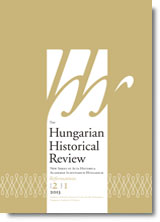Tolerant Country – Misunderstood Laws. Interpreting Sixteenth-Century Transylvanian Legislation Concerning Religion
Tolerant Country – Misunderstood Laws. Interpreting Sixteenth-Century Transylvanian Legislation Concerning Religion
Author(s): Mihály Balázs Subject(s): History
Published by: Magyar Tudományos Akadémia Bölcsészettudományi Kutatóközpont Történettudományi Intézet
Summary/Abstract: In this essay, I offer a new interpretation of the religious laws that were passed in Transylvania between 1568 and 1571. I conclude that the interpretations that have been ventured so far in the secondary literature have failed to provide a concrete analysis of the relationships between different confessions, either because of national prejudice or because of general ignorance of prevailing conditions at the time. As a consequence, a view has gained acceptance in several comprehensive works according to which, by recognizing the four confessions in Transylvania, lawmakers sought to ensure the survival of the newly emerged principality. I offer a thorough study of the texts of the laws in support of my contention that this is not the case. The laws include no specific list of the four confessions. The first such list dates from 1595, the year after which the laws make mention of the Orthodox religion of the Romanian speaking population as a tolerated religion. As my analysis clearly demonstrates, up until the end of the century the most important goal of the laws was the continuous assertion of the Protestant identity of the Principality, and paradoxically this did not even change in 1571, when the Roman Catholic István Báthory came to the Transylvanian throne. Until the middle of the 1570s this Protestant identity was essentially undivided due to the unparalleled slowness (in comparison with the rest of Europe) of the spread of confessionalism. It is worth noting that until the early 1570s the prince and those closest to him saw the restoration of Protestant unity in Europe as the mission of Transylvanian Protestantism, and this meant attempting to spread Protestantism among the Orthodox communities of the country. At the same time, the estates in Transylvania, a principality that saw itself as fundamentally Protestant, sought to ensure the preservation of conditions necessary for the survival of the religious lives of the dwindling number of Catholics.
Journal: The Hungarian historical review : new series of Acta Historica Academiae Scientiarum Hungaricae
- Issue Year: 2/2013
- Issue No: 1
- Page Range: 85-108
- Page Count: 24
- Language: English

